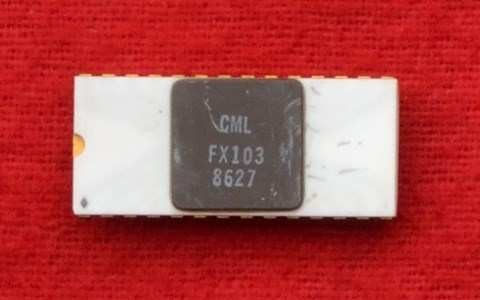FX103 QTC Decoder
Features
- 1 To 5 Digit Address Decoding
- Audio Unmute Switch Output
- 2nd Address Decoding
- Call-Coded Mute Reset
- Group & All-Call Decoding
- 'Absent Page' Memory Recall
- Coded-Bleep Alert Output
- Preamble Mode Option
- On-Chip Alert Timeouts
- Low Power CMOS Process
Description
The FX103 is a versatile and powerful address decoder designed for use in pagers, portable transceivers and mobile radios using tone coded selective signalling. It accepts 4-bit ’QTC coded’ output characters from an FX003 tone decoder and compares them with an address code held in a diode ROM. When the correct code sequence is received the FX103 outputs a coded-bleep alert signal. A 2nd distinctive alert pattern is generated if the ’2nd Address’ code is received, and a 3rd pattern is output for valid group codes. A further pattern is generated on power-up (not applicable during the power cycling routine in Preamble mode).
The FX103 operates by the advanced ’HSC’ decoding rules, which ensures freedom from cross-code responses and noise triggered false calls.
The alert output signal automatically times-out after 10 seconds unless reset earlier by the Alert Reset input. Alerts which are not reset by the timeout period are ‘memorised', and may be recalled by operating the Alert Reset input at any later time. The memory outputs the coded pattern of the last ’absent’ call received.
Audio unmute output is provided and is switched (unmute) for every valid call. It may be reset manually, through the Mute input, or remotely by an address or group call containing the ’Mute’ suffix code. A different suffix code allows the memory contents to be erased if, for example, an action is no longer required.
Only the primary address code needs to be programmed in the ROM; group and suffix codes are decoded on-chip. Addresses are programmed 'as written’; consecutive identical digits are automatically translated into ’E’ characters (repeat) on-chip. If character E is programmed into the ROM, it acts as a termination of the preceding address code digits and therefore permits shortened codes (1 to 4 digits) to be used.
No termination is required in the ROM for 5-digit codes or 6-digit Preamble mode codes.
As an alternative to a diode ROM, decimal to binary encoder may be used, and the decimal sequence outputs Q1-Q5, or Qp-Q5, linked to the encoder inputs in the required code sequence.
FX103 pin-select options include Group Digit '0' (numeric zero becomes the group digit in place of the normal HSC digit ’A’). All-call Inhibit (a group digit received in the Preamble or 1st digit code positions becomes invalid) and Decode Abort (forces invalid at any stage in a decode sequence). The latter facility is useful for imposing externally determined timing limits etc. on the interval between successive code characters, should formal compliance with older signalling standards be required.
A further option is Preamble mode, which is sometimes used to reduce battery drain in pagers. When Preamble is selected, the Qp output is enabled and is used to select the preamble digit programmed into ROM. On power-up, the first ’non-F’ digit received must be the preamble digit or the device locks-out into the inhibit condition. The inhibit state can only be cleared by powering down. If the correct preamble digit is received following power-up the FX-103 reverts to normal decode mode, i.e. looks for the address programmed by Q1 through Q5 following HSC decoding rules.
Decode Truth Table
Decode mode NORMAL; 5-digit address code '12345’ in ROM.
Decode mode PREAMBLE; preamble digit '6', address code '12345' in ROM.
The following input character sequences include all valid codes. Note that the 103 employs OPEN CODE rules when decoding Address Suffix characters, i.e. receipt of the correct suffix code characters is valid without further qualification or termination.
For simplicity, only one group code is used as a Group Code example; any valid HSC Group Code may be used. Only one valid Preamble code is shown, any valid NORMAL code is valid with PREAMBLE.
Input Code Decode Function
F12345F Address alert, audio unmuted
F123453 Address alert, audio unmuted
F12A45F Group alert, audio unmuted
F12A4SB Group alert, audio unmuted
F12345C 2nd Address alert, audio unmuted
F12A45C 2nd Address alert, audio unmuted
F12345DC No alert output, mute audio output
F12A45DC No alert output, mute audio output
F1234SDC No alert output, mute audio output, erase memory
F12A4SDC No alert output, mute audio output, erase memory
F123 Invalid address, inhibit decoding until next ’F’
*(PUR)F6F12345F Address alert, audio unmuted
*(PUR)6F12345F Address alert, audio unmuted
*(PUR)F61 Invalid address, inhibit decoding until
*(PUR)61 next 'F', recommence '12' etc.
*(PUR)F6F123 Invalid address, inhibit decoding until
*(PUR)6F123 next 'F', recommence '12' etc.
*(PUR)F7 Invalid preamble, inhibit until next PUR
*(PUR) (F or 6) Invalid preamble, inhibit until next PUR
